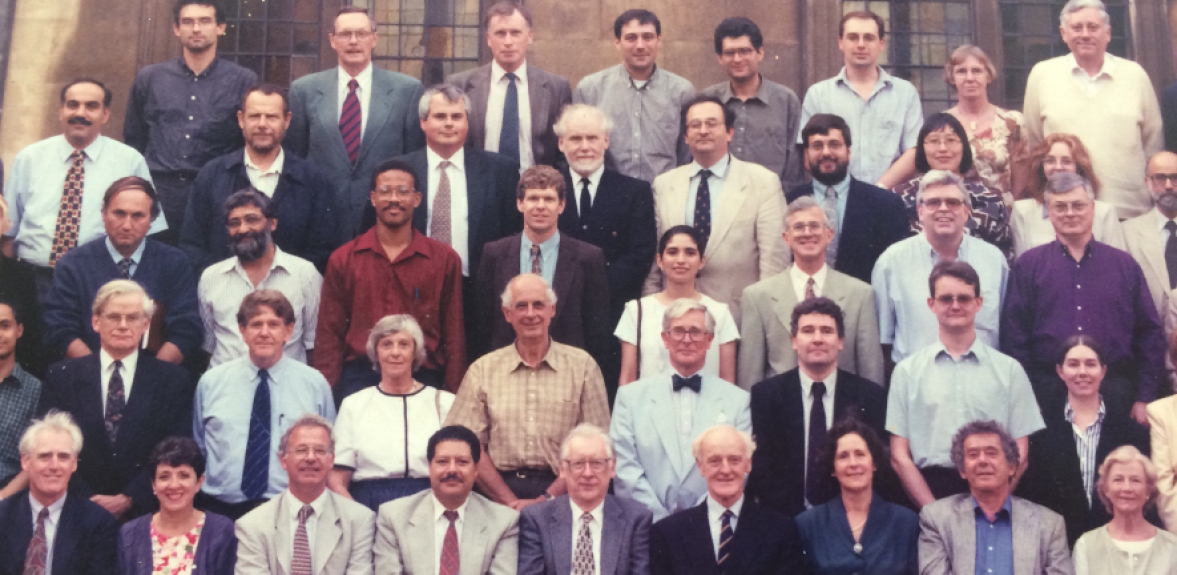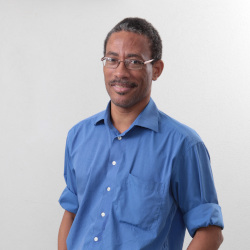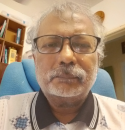
Professor Buckingham's retirement conference, Pembroke College 1997. Sean McDowell is in the third row in the red shirt. Seated in the front row to Prof Buckingham's right are his former PhD supervisor, John Pople, who was the 1998 Nobel Laureate, and to Pople's right, Ahmed Zewail, who was the 1999 Nobel Laureate.
Sean McDowell: Reflections after the passing of my long-time collaborator, Professor A. David Buckingham
 Sean McDowell is the Professor of Theoretical and Computational Chemistry, University of the West Indies in Barbados, and a Fellow of the World Academy of Sciences, which supports science in the developing world. He completed his PhD in 1992, supervised by Professor Buckingham, and has written this tribute
Sean McDowell is the Professor of Theoretical and Computational Chemistry, University of the West Indies in Barbados, and a Fellow of the World Academy of Sciences, which supports science in the developing world. He completed his PhD in 1992, supervised by Professor Buckingham, and has written this tribute
Professor A. David Buckingham FRS CBE, who died on February 4th 2021, was one of the world’s leading authorities on the electric, optical and magnetic properties of matter and a giant in the field of intermolecular forces. He is also a member of that rare class of scientists who have had the singular distinction of a scientific unit named in their honour - the Buckingham is the cgs unit of the electric quadrupole moment. A recent Biographical Memoir of the Royal Society gives a good overview of his outstanding scientific contributions, distinctions and achievements, both scientific and non-scientific.1
The account which follows is a more personal account of my relationship with this outstanding scientist. I first met David Buckingham more than thirty-two years ago sometime in November 1988. I had arrived at the University of Cambridge from Jamaica on a Tate and Lyle Commonwealth Scholarship. I was late for the term, arriving at the end of October because of the devastating effect of Hurricane Gilbert, one of the most intense hurricanes of the 20th century, which scored a direct hit on Jamaica, razing the entire island from east to west.
I was nominally assigned to Professor Buckingham since he was Head of the Theoretical Chemistry section of the Cambridge University Chemistry Department and I had not vouched beforehand to work with any particular staff member. However, when I arrived in the Department, Prof Buckingham was away in India delivering talk(s) in celebration of the centenary of the birth of the great Indian scientist C. V. Raman. I eventually met Buckingham on his return from India and was immediately struck by his warmth, charm and easy candour. Even though he stated that I was not compelled to work with him and he encouraged me to explore the research of the other staff members in the section to see if I would prefer working with someone else, I decided to remain as his graduate student.
This turned out to be the right decision, as over time I found our personalities to be very compatible and I am grateful to have benefited, not only from his rigour and profound scientific insights, but also from his generosity of spirit and great sense of humour. I recall his suggestion to bring his cricket bat to shore up the West Indies batting at a time when they were struggling against the English cricket team who were playing in Barbados sometime in 2004. I completed my PhD in Theoretical Chemistry in 1992, focused mainly on the properties of van der Waals molecules, with a special emphasis on hydrogen bonding. Our association continued due to a 6-month stint in the Department as assistant editor of Chemical Physics Letters, facilitated by Prof. Buckingham who at the time was the main Editor of the journal. This hiatus gave me time to secure a postdoctoral appointment with Professor Bill Meath at the University of Western Ontario (UWO), London, Canada in 1993.
After three years In Canada, I accepted a temporary Lectureship at the University of the West Indies, Cave Hill campus, Barbados in 1997, eventually ascending the ranks to Full Professor in 2005. We remained in touch, on and off, since my appointment in Barbados, but actively re-established a very relaxed and informal research collaboration from 2003 onwards, spanning a 14-year period – my last visit being in summer 2017. Our ongoing collaboration enabled me to return to the Chemistry Department as a Visiting Scholar during consecutive summers, resulting in a total of twelve papers in journals such as Journal of the American Chemical Society, Chemical Physics Letters, Journal of Chemical Physics and Molecular Physics, our last publication being in 2018 in ChemPhysChem.
Our meetings were always very relaxed affairs. I would meet in his office, which was shared by other Professors emeriti, but we were usually the only ones there. A lively discussion about the latest travails of the West Indies cricket team was the usual catalyst for our talks, followed by discussion of some promising new line of research that I was pursuing or an ongoing project left over from my previous summer’s visit. All such discussions would be enthusiastically received by Prof Buckingham, who with characteristically sharp insight, would unearth some interesting new path(s) to follow. He was genuinely interested in my work and always willing to join forces with me to hone what would eventually result in a final polished product.
I was particularly pleased with our Journal of the American Society paper of 20052 in which we sought to illuminate and debunk some misconceptions that had arisen in the literature concerning various aspects of hydrogen bonding, particularly of the blue-shifting variety. This article was published while I was on a year-long leave from my university and supported by an EPSRC Visiting Fellowship to Cambridge in 2004-2005. Our collaboration produced several papers which applied Buckingham’s powerful theory of the solvent shift in vibrational spectra, developed between 1958 and 1960 using quantum mechanical perturbation theory. This theory was successfully extended to the prediction of the geometrical and spectroscopic changes of the proton-containing covalent bond in small hydrogen-bonded molecular complexes.
I am also grateful to Prof Buckingham for inviting me (as well as Prof Janet del Bene) to contribute to a 2008 Frontiers article in Chemical Physics Letters on hydrogen bonding3, which has turned out to be my most cited publication (with over 278 citations to date, according to Google Scholar). My contribution was on blue-shifting hydrogen bonds, which was a somewhat “hot” topic over the 5-year period preceding the publication of this paper. Our 2018 ChemPhysChem paper was the last paper that was published by Prof Buckingham, and has racked up a healthy number of citations so far.
I will always treasure the memories of the 2004 visit of Prof Buckingham and his dear wife Jill to Barbados, where he delivered a very well-received and enlightening historical public lecture on the history of science at Oxford and Cambridge, as well as a scientific lecture in my own Department of Biological and Chemical Sciences at the Cave Hill campus of our University of the West Indies. My wife Zanifa and I fondly remember the wonderful evening spent with David and Jill at our home in the company of our three daughters, where we enjoyed my wife’s delicious cooking and her special fruit-infused rum liqueur, resulting in a quite delightful evening. Their visit to Barbados was an unforgettable highlight of our friendship.
Our collaboration was consequently, not only academically rewarding, but also allowed for very interesting non-scientific discourses and very warm social interactions. He was a brilliant scholar and a true gentleman, imbued with charm, good graces, great wit and humour and I will forever be grateful for his long and unwavering support of my career for all these years, first as my PhD supervisor and subsequently as a long-standing research collaborator. One could not have asked for a better scientific colleague and friend. I will miss him very much. I am sure that his many and varied accomplishments in the field of theoretical chemistry, especially his ground-breaking work on the theory of intermolecular forces, and his more recent investigations of the effect of chirality in NMR spectroscopy, will continue to inspire present and future researchers.
I wrote a short poem in honour of his memory, which is below.
Who now with the glint in his eye?
He confronted the puzzling aspects
With great aplomb and fine intellect,
Trying to unlock the mystery
With razor-sharp insight
Its essence to dissect,
But who now with the glint in his eye?
And who now to probe the reasons why?
Though he’s gone
Far from the never-ending fray
Never you mind
We shall meet again some other day
And when misty eyes cry
O but he has gone so far away!
I shall happily reply,
Seek solace in these treasured memories
Whilst the flickering light is still in play!
References
[1] David C. Clary and Brian J. Orr (2021). Amyand David Buckingham. 28 January 1930—4 February 2021, Biogr. Mems. Fell. R. Soc.
[2] Sean A. C. McDowell and A. D. Buckingham (2005). On the Correlation between Bond-Length Change and Vibrational Frequency Shift in Hydrogen-Bonded Complexes: A Computational Study of Y···HCl Dimers (Y = N2, CO, BF), J. Amer. Chem. Soc. 127, 15515–15520.
[3] A. D. Buckingham, J. E. Del Bene and S. A. C. McDowell (2008). The Hydrogen Bond, Chem. Phys. Letts. 463, 1 – 10.
Christopher G. Jesudason: Some comments on the sad passing away of David Buckingham
 Christopher Jesudason is the retired Professor of Theoretical Chemistry at the University of Malaya, Kuala Lumpur, but remains active in research and commentary.
Christopher Jesudason is the retired Professor of Theoretical Chemistry at the University of Malaya, Kuala Lumpur, but remains active in research and commentary.
I recently and belatedly came across the notice in Chem@Cam (Issue 62) of the very sad passing away of David Buckingham, who taught me Quantum Mechanics (Yr. II, 1978).
Many have commented on the reluctance of major powers in training rigorously scientists from the Third World (TW), in particular those who were destined to return there. The list of commentators include eminents such as Abdus Salam, in his off-the-record remarks and in his more formal writings, where a spirit of “possessiveness” is deemed the underlying cause of the reluctance. Risto Nieminen, during my personal conversation with him when he was head of department in Helsinki University of Technology (~2007), emphasized his profound concern that the scientific levels and functionality between the TW and the West (echoing some aspects of Salam’s own concerns) had advanced to an almost unbridgeable chasm.
I do not recall any details of this apparent chasm, but observation would certainly suggest such factors as poor historical recall, technical and scientific media development and social connectivity, let alone poor technical and theoretical know-how derived from a firm anamnesis capability. My own view based on observation is that returnees may very well be deployed for other purposes, such as their being established for the purposes of setting up ancillary research facilities where secondary research of the themes developed by the major powers is re-enacted. It is a rewarding and well-cited, relatively risk-free enterprise for such participants, whose research interests in such cases are in the main not a response to environmental, societal and community stimuli coupled with in-depth interest and expertise.
I did keep very brief, informal and sporadic contact with David, up to at least 2010, attracted by his work, encouragement, cordiality and warmth. He remembered people well, and shared in their concerns as best as he could. The orations at the funeral service in the Pembroke chapel available on the web attest to these affable and kindly qualities. Furthermore, David belonged to the twilight generation of the vast British empire and pre-EU Commonwealth, where I maintain that the relationship of Britain to this Commonwealth was not entirely and absolutely mercantile and exploitative if compared to the more polite convoluted arrangements of current times, where the economic and other statistics speak for themselves.
As a muted TW academic, I am of the view that David did not add significantly, if indeed at all to the ever widening research chasm and collegial distance of current times between the TW and the so-called advanced nations. His death signifies for me the passing away of an era where the quality of empathy and commonality - that he reflected in such broad measure - were more evident amongst peoples and nations and in particular academics, and which unfortunately has been hastily driven into near extinction.
